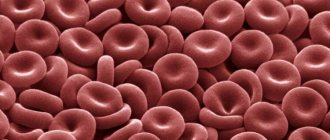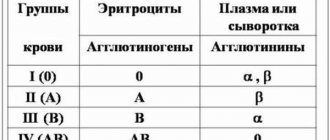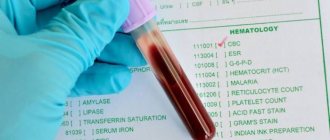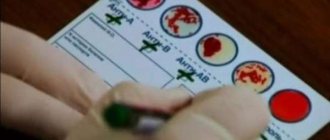The third blood group is considered rare - it is found in only 15% of people inhabiting the Earth. According to some reports, we owe its appearance to the nomadic Mongoloids. The age of the group is more than 17 thousand years. The third negative is, accordingly, even less common. It is more common among people living in Asian countries, the Middle East, and Africa. Interestingly, some researchers say that it determines a person’s character. So let's get to know the third negative category in detail!
The third group is compatibility during donation
A person with group 3 will not be a universal recipient. In other words, his blood for transfusion is not suitable for everyone. Blood of the first group is universal. But for those with the 4th category, blood of all groups is suitable - 1, 2, 3 and 4.
Here's what concerns the third blood category in this vein:
- A person with group 3 can become a donor for people with blood categories 3 and 4.
- It is permissible for a person with blood group 3 to receive blood transfusions of the first and third categories.
- The 3rd positive and the 3rd negative are incompatible! Rejection can even be fatal for the patient.
If it is not possible to transfuse suitable blood to a person in need, then specialists use serum or blood substitutes (“artificial blood”) - special sterile liquids that can replace it itself, as well as plasma. Such compositions are not a complete alternative, but are capable of supporting human life.
The rarest blood type
Scientists have proven that most people have the first blood group, so the figures are as follows (41%). The second stage is given to the second group, which currently has 32%, the third has 22%, and the fourth blood group has become the most unpopular, which can account for only 5% of all humanity.
If you have group 4 and a negative Rh factor, then you can very easily be forced or asked to donate your blood for transfusion to someone. With such a unique masterpiece you can save one or more people.
Rh factor value
So why is the third negative incompatible with the third positive? It's all about the Rh factor (+/-). It was discovered by scientists A. Wiener and K. Landsteiner in 1940.
The Rh factor is a special antigen that is found on the surface of erythrocytes - red blood cells. Interestingly, it does not change throughout a person’s life, and is also transmitted from parent to child.
According to statistics, 85% of the population of our planet have a positive Rh factor and only the remaining 15% are negative (that’s why there are so few people with the third negative group). The meaning of the difference is as follows:
- Blood of the same group, but different Rhesus is incompatible! Transfusion can have consequences for the patient, including death.
- It is important to note that different rhesus diseases with the mother threaten the child with death in the womb. For example, if a woman has third negative blood, and the baby has third positive blood, then the embryo is in danger.
Country Analytics
Blood group statistics in the world are distributed as follows:
- I – 45%.
- II – 35%.
- III – 13%.
- IV – 7%.
Blood group statistics vary significantly across countries. The rarity of a group depends on the time of its origin. The championship is given to the I Civil Code. Statistics of people by blood group with a negative Rh factor have a smaller percentage of people. Statistics on blood groups and Rh factor around the world are as follows:
According to Wikipedia, the percentage of blood types in the world occurs in mysterious ways. For example, the Peruvian Indians, Bororo and Chomen have - I (100%). Population of Hawaii - II (61%).
Therefore, it is possible to determine nationality by blood group. For the European race it is characteristic – II, for the Negroid race – I. For Asians – III. China has the largest number of people with 3+ among other countries. However, in China, the fewest people have 4-.
Scientists have found that in Ukraine people with blood group II are at greater risk from cancer.
Blood group statistics in the Republic of Belarus show the same number of people between I and II. The country is constantly in need of donors as it carries out complex operations, including organ transplants. In donor centers in Belarus, the components of blood groups are divided into components: red blood cells, platelets, plasma.
It is worth recalling that donors regularly renew their blood in their bodies, which strengthens their immunity.
Compatibility of father and mother
We now know that the discrepancy between the blood characteristics of a pregnant woman and the embryo has serious consequences. They are especially severe in the case when the child has a third negative blood group, and the mother has the first or second. But let us note once again that the danger is real only for problematic pregnancy.
But now let’s move on to the Rh harmony of father and mother. Let's look at the compatibility of parents who have blood group 3:
- The third is negative in a woman. A suitable father is with blood types 1 and 3.
- The third is negative in a man. A suitable mother is with the 3rd and 4th blood groups.
What threatens the incompatibility of mother and father by Rhesus?
Complexes with this research
Future dad Comprehensive examination to prepare a couple for conception 8,460 RUR Composition
Expanded hospital complex Expanded infectious screening for prevention and hospitalization 7,700 RUR Composition
Entry into IVF Examination when a woman enters the IVF procedure RUB 23,020 Composition
IN OTHER COMPLEXES
- Pregnancy planning. Clinical indicators 6,630 R
- Preparation for IVF for a man 6,060 RUR
- Examination during pregnancy. 1st trimester 16,690 RUR
The danger of Rh-conflict between parents
Everything is simple here - a mismatch in the Rhesus of the parents causes a mismatch in the Rhesus of the mother and the embryo. After all, as you remember, it is inherited.
Rhesus conflict is dangerous for mother and baby in the following ways:
- Stillbirth of a child.
- Miscarriage is a spontaneous abortion.
- Fading pregnancy is stopping the development of the embryo in the mother's womb.
- The appearance of pathologies in the fetus that are incompatible with life.
It is important to note that open Rh conflict will manifest itself only in the last months of pregnancy. Before this, it can affect the abnormal formation of the internal organs of the embryo - mutational changes are possible.
Doctors also note the fact that when parents have a Rh conflict, the first child is born without problems in most cases. And the second baby will be in danger. Therefore, if the first pregnancy went perfectly, a woman should still carefully prepare herself for the second.
However, Rh mismatch is not a 100% predictor of dire consequences. Today, future parents can undergo a course of special treatment, which significantly increases the chances of having a healthy and healthy baby.
Even if there is Rh harmony between the father and mother, planning a child still needs to be approached with all responsibility - use tests to determine ovulation, regularly visit a specialist and follow his recommendations, follow a diet, a healthy lifestyle, etc.
What to pay attention to during treatment
Due to the tendency to blood clotting disorders, medications containing aspirin and Gingko Biloba should be taken with caution. To protect the intestines, it is recommended to use probiotics to maintain intestinal flora.
Herbal treatment works well for people with the first blood group. Decoctions of mint, rose hips, tinctures with linden blossom, and ginger soothe. Not recommended: aloe in various forms, tinctures of burdock, corn silk.
Psychologists advise people with blood type O to stop fussing and fight narcissism and arrogance towards others. You should not rush things and seek power at any cost. This can lead to total loneliness.
Physical characteristics of the group
It is noted that people with the third blood category for the most part have strong immunity. However, for this group there are a number of diseases to which, according to statistics, they are most susceptible:
- Inflammation of the lungs - pneumonia.
- Apathy, depression.
- Sclerosis.
- A number of joint diseases.
- Osteochonrosis.
- Autoimmune diseases.
- In women, complications develop after childbirth.
You should not assume that every person with blood type 3 must necessarily get sick from this entire list. This is just a reason to remember your exposure - lead a healthy lifestyle, monitor your emotional state, eat healthy foods
Character traits
To combat difficulties, people with the first group are endowed by nature with high volitional abilities. Such people become leaders, regardless of what they call the people to. They are able to achieve a goal without worrying about moral characteristics.
The study of character traits made it possible to establish the presence of increased emotionality and a developed sense of self-preservation. Such qualities of a leader allow him to calculate the degree of risk, think first of all about his own benefit, and analyze the result of his work.
They do not tolerate criticism and are jealous. They are more likely to be suited not for professions, but for positions with a leadership focus.
Psychological characteristics of the group
Surprisingly, the ratio of antigens (A and B) affects not only the physical characteristics of a person, but also his psychological portrait! In this vein, the third negative blood group in women and men is manifested by the following personal characteristics:
- High level of creativity.
- Cunning and wisdom.
- Manifestation of some selfishness in behavior.
- Excellent oratorical qualities - emotional speech, a penchant for diplomacy. In other words, these are people who are capable of leading.
- Frequent and rapid mood swings, some nervousness.
- Sometimes there is excessive emotionality.
- Carriers of the 3rd blood group are most often surgeons, lawyers, accountants, and representatives of other serious professions.
Types of blood
Blood, like people, differs from each other and we all know about this from school. It is very important that the donor’s blood is ideally suited to the patient, which is why you need to know its type. This will help not to destroy a person, but rather to save him.
Checking your blood type makes it possible to know about its compatibility with others.
- the first (I), contains neither A nor B;
- the second (II) – consists only of A;
- third (III) – only B;
- fourth (IV) – both A and B are present here.
As much as 60% of blood consists of plasma. Plasma is a yellow-white liquid consisting of water and proteins, as well as salt, vitamins and microelements.
40% of blood consists of cells, they can also be called blood cells or cells. There are several types of cells that do different tasks.
- Red blood cells (erythrocytes).
- White blood cells (leukocytes).
- Plates from blood (platelets).
The human body contains most of the red blood cells, also called red cells, or red blood cells. They make up 99% of blood cells. From 4 to 6 red blood cells are found in 1 microliter of blood.
The most important and significant part of their work is that they carry oxygen through the vessels, which the human body needs most of all, which passes through all tissues of the body, as well as organs. Hemoglobin is what helps the red pigment perform its tasks.
Perhaps there are few red blood cells in the human body, or there is a lack of hemoglobin in them, then they cannot fully perform their functions, and anemia or anemia occurs. People with anemia have pale skin. The body does not receive the necessary oxygen, resulting in shortness of breath, fatigue, dizziness, headaches, heart pain, back pain, and decreased ability to work.
In the work of red blood cells, the main thing is not the amount of blood, but the volume and level of hemoglobin.
White blood cells or in simple words - leukocytes occupy only 1% of all blood cells in humans. A level of 5 thousand to 8 thousand leukocytes per microliter of blood is considered normal.
They are responsible for the immune system and human defense. Leukocytes are able to recognize and neutralize all bacteria, fungi and viruses. If there is some kind of infection in the body, the level of white blood cells can increase several times in a few days. The body begins to quickly fight the disease and its causative agent.
The white blood cell count can be easily measured through a blood test. They can also be measured by the leukocyte formula.
White blood cells are lymphocytes. 70% of lymphocytes are found in the tissues of the lymphatic system. These include the lymph node, tonsils (pharyngeal tonsils), spleen, and thymus gland.
Lymphocytes are found in lymph, a watery fluid that is colorless and found in the lymphatic vessels. It is precisely with the blood itself that it completely covers the entire body.
Common health problems
Depending on the blood type, there is also an innate tendency of a person to certain diseases. This does not mean that the patient will one hundred percent develop a certain group of ailments: if you are attentive to your health and engage in prevention, they can be avoided.
But if you leave everything to chance, and do not adhere to recommendations regarding nutrition and physical activity, the risk of these diseases increases significantly.
| Weakness | The most common diseases |
| Gastrointestinal tract | Ulcer of the stomach and duodenum |
| The cardiovascular system | Hypertension, hypertensive crises, risk of stroke |
| The immune system | Weakened immunity, autoimmune diseases, allergies |
| Respiratory system | Frequent colds, flu, pneumonia, tuberculosis |
| Joints | Arthritis and arthrosis, which can appear at a young age |
This group is also characterized by problems with the thyroid gland. And in men there is an increased tendency to hemophilia.
(
1 ratings, average: 5.00 out of 5)











